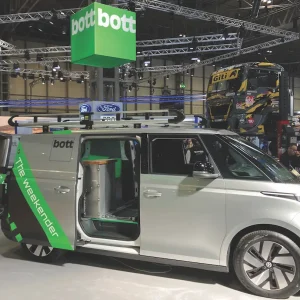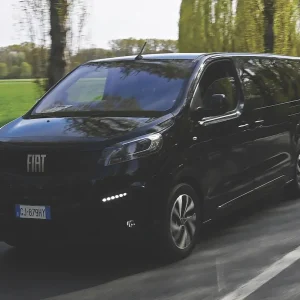Nissan is targeting the booming ‘last-miles’ urban delivery market with its new increased-range e-NV200.
The mid-size, zero-emission-at-source electric van has sold 15,000 units across Europe since officially going on sale in 2014, but with its new beefed-up battery version – from 24kWh to 40kWh – its range capability has improved by 60%, from 110 miles to 174 miles on the New European Driving Cycle (NEDC), so the Japanese brand is now hoping to make a bigger splash. Even on the new more real-world Worldwide Harmonised Light Vehicle Test Procedure (WLTP), the e-NV200 still records a claimed 125-mile combined figure and 188 miles for the city, which is useful for its intended stomping ground.
Unsurprisingly, then, Nissan’s UK managing director Alex Smith is excited about the enhanced e-NV200’s prospects in this growing market – largely created by internet shopping and quicker delivery offers – but he also acknowledged that this boom is attracting serious political attention for its associated emissions increases.
“A third of all LCV journeys are made in urban areas, but 90-95% are currently made with diesel engines,” he explained. “We’d like more to use electric motors. With the average LCV covering 13,000 miles per annum – equating to 50 miles per working day – urban deliveries can absolutely be made with an e-NV200. With running costs on average four times cheaper than diesel and lower service, maintenance and repair too, it’s an environmental and economic win.”
Although the new 40kWh battery is more powerful, Nissan stresses that it takes up no more room than the old 24kWh model, so has no impact on the van’s 4.2m3 loadspace. The new battery will also be offered in the seven-seater electric taxi version of the e-NV200. While pretty much everything else is as before for both versions (including the 109hp power output) Nissan says the navigation system inside has been improved in terms of user experience and also look and feel.

Featuring the same battery as in the new Nissan Leaf compact hatchback, recharging times are 21.5 hours from a domestic 10A three-pin plug, 5.5 hours from a new sub-£1,000 7kW wall box (quicker than the existing 6.6kW’s 7.5-hour offering with the mk1) or just one hour to 80% range from a 50kW quick-charger.
Nissan is also targeting fleets by introducing an easy-to-install, more cost-effective mid-range 22kW unit that can fully ‘refuel’ in two hours.
“Feedback from business was that slow-charging and expensive investment were issues,” said Nissan Europe’s electric vehicle director Gareth Dunsmore. “While we offered a 50kW quick-charger before [and still will], we could only install them via partner firms and the cost with planning applications and digging holes could be £5,000-£50,000. This 22kW charger is ‘plug-and-play on the wall’ and fitted in-house, so much cheaper.”
While Nissan’s UK charger price structure has not yet been made public, Dunsmore said the 22kW version would be in the “low £1,000s plus the day-rate of an electrician”, and thus a massive saving in time and money. Meanwhile Nissan has pledged to expand its European public quick-charging network from 4,600 currently to 5,600 by 2019 (up 20%).
Dunsmore also trumpeted the opportunity for businesses to potentially earn money from their electric vans’ spare energy via bi-directional charging. Connected to an office or depot when parked, the idea is they will be able to help balance the electricity grid by either topping it up or acting as extra storage space. Dunsmore reckoned businesses could earn £35 per week for hooking up their fleets in such a way.
Official prices for the spring 2018 launch were unconfirmed at the time of going to print but should be in line with current models, so circa £17,250-£20,000 (minus VAT) for the e-NV200 van and £24,500-£28,250 (inc. VAT) for the extra-seated Combi (all with the full £4,500 Government plug-in grant).





